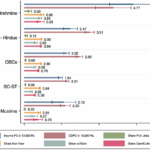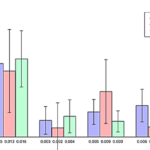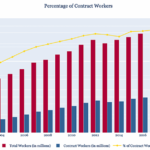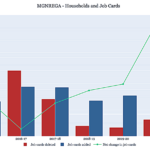Dominant or Backward? The Maratha Quota Controversy
The description “backward” to define communities is yet another colonial relic which we, as a collective, embrace with such enthusiasm, that we almost forget what it is supposed to mean. Nowhere is this more apparent than in the arguments in favour of reservations by landowning castes that are politically and economically dominant. The demand for being classified as “backward” by Marathas has been ongoing since the 1990s. With the announcement of the Socially and Educationally Backward Communities (SEBC) Act, 2018, the Maharashtra government had, yet again, yielded to the demands of this powerful caste group. This was the third attempt in five years to grant this quota, which has been repeatedly struck down by the courts. And it was struck down once again by the five-judge Constitution Bench.
The Court has held that the 2018 Act violates the principle of equality and by exceeding the ceiling of 50 percent, goes against Articles 14 and 15 of the Indian Constitution that guarantee the right to equality and protection against discrimination.
A great deal of the focus of the discussion on this order is on whether the 50 percent ceiling is valid and whether reservations should be a state or central subject. There are genuine issues of federalism involved which must be discussed; in particular, states must have a say in determining which groups are deserving of special policy focus. Also, the 50 percent ceiling is arbitrary: the case for compensatory or protective affirmative action should be assessed in relation to the actual evidence, not an inflexible ceiling deemed appropriate and valid for all cases.
In this article, we focus on the objective evidence related to “backwardness” of three communities, i.e., examine the justification for extending reservation to them, not based on the 50 percent rule, but based on where they stand in the socio-economic ranking relative to other communities in their respective states. We also discuss why they are demanding reservation, and what can be done to address their genuine and legitimate anxieties.
Why are dominant castes demanding reservations?
The ferocity with which dominant castes – mostly rich, landowning, politically influential communities – Marathas in Maharashtra, Patidars or Patels in Gujarat, Jats in Haryana, Kapus in Andhra Pradesh – have turned towards the state and the public sector, demanding quotas in jobs and higher education, indicates that economic growth following liberalization did not manage to swing the fortunes of a large proportion of these communities upward enough. The rate of growth started to peter off around 2013 and has been continuously declining ever since.
Their demand for being included in the quota bandwagon can be seen as an expression of their desire for good jobs and stable sources of livelihood for their youth, as their traditional sources of livelihoods become more fragile due to a widespread and multifaceted agrarian crisis.
Yet, quotas are not magic wands that create jobs. And everyone would like a good job or a decent stable source of livelihood. Given that public sector jobs represent a shrinking and much coveted pie, what should be the yardstick to determine the validity of the demand for quotas?
What does the evidence tell us?
In a paper published in Economic and Political Weekly (May 13, 2017), we looked at data from the India Human Development Survey (IHDS), and focused on Jats in Haryana, Patels in Gujarat and Marathas in Maharashtra. We compared these three caste groups to Brahmins, non-Brahmin forward castes, existing Other Backward Classes (OBCs) and Scheduled Caste and Tribes (SC-STs), in their respective states.
The results were stark. We found that Marathas, like Jats and Patels, are more likely to own or cultivate land than all other social groups in their respective states (see Figure 1 below). Figure 1 shows that 49 percent of Marathas, 57 percent Patels and 82 percent Jats own or cultivate land. The corresponding proportions for all other groups are smaller.
Figure 1

Marathas have a lower per capita consumption expenditure (INR 27,672 in 2011-12) than Maharashtra Brahmins but are at the same level as other forward castes and OBCs, and significantly higher than SC-STs (see Figure 2 below). Patels have a higher per capita expenditure (INR 38,934) among all social groups in Gujarat, even Gujarati Brahmins. Jats in Haryana have the second highest per capita educational expenditure among all social groups, similar to Marathas.
Figure 2

14 percent of Marathas are below the poverty line, which is higher than the poverty rate among Brahmins, but lower than OBCs (16 percent) and far lower than SC-ST (27 percent) (Figure 3). Patels and Jats have the lowest incidence of poverty in their respective states (6 and 2 percent, respectively).
Figure 3

Educational gaps: One source of anxiety
Figure 4 (below) shows the years of education for the major groups in the three states. Here one starts to see the basis of their demands. Marathas, Patels and Jats lag behind Brahmins and other forward castes in terms of years of completed education.
Figure 4

Figure 5 (below) shows the share of groups with secondary education or more. Here the difference with Brahmins in the state is brought about starkly: 32 percent of Brahmins have secondary education or more in Maharashtra, compared to 19 percent Marathas. In Gujarat, the corresponding proportions are 30 percent Brahmins and 20 percent Patels; in Haryana, 24 percent Brahmins and 17 percent Jats.
Figure 5

Summing up, in most of the crucial socio-economic indicators, the Marathas are second only to Brahmins in the state and are significantly better off than all other social groups. The relative position of Patels and Jats is analogous in Gujarat and Haryana, respectively.
Perceived social status: Self-reported practice of untouchability
The IHDS has a question on self-reported practice of untouchability towards Dalits. The stigmatizing practice of untouchability is legally abolished and punishable by law. Thus, self-reporting is likely to underestimate the widespread overt and covert instances of untouchability. Despite this, the proportions reporting practicing untouchability is shockingly high. These proportions are a rough indicator of how much “higher” the groups see themselves in relation to Dalits (the lowest ranked group in each state).
In Maharashtra, reported untouchability is low and similar across groups. In Gujarat, self-reported practice of untouchability is high; the share of Patels admitting to practicing untouchability (30 percent) is lower than for Brahmins (54 percent) and forward castes (40 percent). In Haryana, self-reporting is high and Jats are number 3 in the ranking, analogous to Patels (see Figure 6 below).
Figure 6

Current access to government jobs
The main bone of contention and the main motivation for quotas is access to government jobs. The surprising fact is that even before being included in the OBC quota, Marathas’ access to government jobs is already like that of Brahmins, and higher than that for other forward castes and OBCs, and not different from that for SC-STs (Figure 7 below). This is one sphere where Marathas differ in their relative position in the state from Patels and Jats, whose access to government jobs is significantly lower compared to Brahmins (and SC-STs, who have been beneficiaries of a quota).
Figure 7

Change over time
We examined both rounds of the IHDS data to see whether the position of these dominant communities deteriorated relative to the other groups. The short answer is no.
In terms of average per capita expenditure, their position has improved over time. In terms of probability of being poor, there is no worsening. There is, however, some evidence of a decline in the probability of owning or cultivating land, which could be the reason for the heightened anxiety.
Factors underlying anxieties
The Marathas are a predominantly agricultural community, which benefited from the Green and White Revolutions. The structural transformation of the Indian economy, especially the declining importance of agriculture, and growth of corporatized agriculture and water shortages affecting productivity, has meant that these groups feel increasingly vulnerable. Yet, data show that the Marathas have lower levels of casualization of the labor force in both the agricultural and non-agricultural sectors, as compared to the OBCs and SC-STs.
Overall, there is discontent among powerful farming communities due to the perception that real economic power lies in the hands of the big corporations, and the state, overtly or covertly, acts in their interest. These communities feel their power slipping away or eroding, in addition to feeling ill prepared to shift towards urban, formal sector livelihood opportunities.
Individuals or communities who feel strongly that the odds of economic success are stocked against them are more likely to feel deprived. Other estimates from IHDS panel data show that “forward castes were about 30 per cent more likely to feel that they were worse off in 2011-12 than in 2004-05″. Thus, perceptions of being worse-off are real: our analysis suggests that these perceptions are exactly that – feelings – not supported by evidence on the ground.
Having said this, economic changes that give rise to widespread anxieties, need to be understood and genuine grievances, including those that might come from forward castes dealing with agrarian transformations, need to be addressed.
Is Reservation the solution to anxieties?
However, is reservation the real answer? Given increasing privatization, the base, i.e. total jobs that are eligible for reservations, is already shrinking. Our other research shows how existing OBCs and SC-STs are further lagging behind upper castes on a range of material indicators. In this context, extending quotas to relatively richer and powerful groups would amount to diluting the already small and shrinking entitlement for communities that are truly disadvantaged and discriminated against.
Recently, the Marathas have had two main demands: one, being made quota beneficiaries, and two, the repeal of the Prevention of the Atrocities Against SC-ST Act. The state government gave in to the first. Should it consider the second, ours would be no country for the most marginalized.
Quite apart from turning the term “backward” on its head, the writing on the wall is clear. Despite the rhetoric that accompanied the 10 percent quota, the plan is not to move to a caste-free system. It is to dilute the entitlement of castes that are objectively “backward”, stigmatized and discriminated against.
In the context of the lynching of Dalits for pursuing their traditional occupations, snatching away their livelihoods in the name of cow protection, violence targeted at inter-caste marriages, and other violence related to temple entry or for not following the illegal social norms dictated by untouchability, this move would have legally reinforced the obnoxious hierarchies of the caste system. A forward looking, progressive Indian polity should be discussing instruments to weaken the deadly tentacles of caste, not embolden and reinforce existing hierarchies.
If you wish to republish this article or use an extract or chart, please read CEDA’s republishing guidelines.




